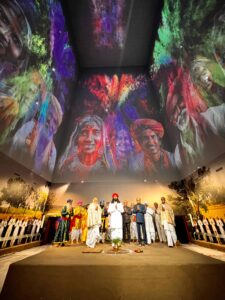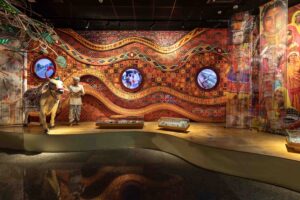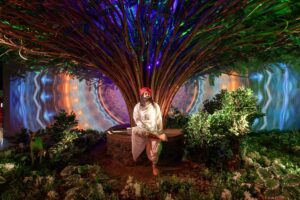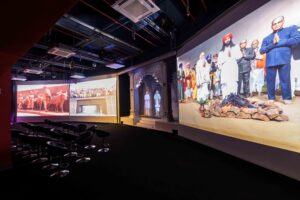BUDGET: 10 crore INR and above (USD1.48 million and above)





Project Overview
The Banjara Virasat museum, located in Poharadevi and commissioned by the PWD department, Government of Maharashtra, was researched, designed, and executed by Delhi-based Design Habit in a record 15 months.
What did the client want to achieve?
The history and the culture of the Banjaras have been modified and assimilated into the majoritarian fold. The Banjaras themselves have forgotten their rites and rituals. Through the museum, the client aimed to preserve the authentic history of the Banjaras and showcase their rites and traditions for future generations.
The Banjaras were labelled and stigmatised as Criminal Tribes. This traumatic label continued even after Independence as denotified tribes. The museum, by sharing its exotic and vibrant stories, aims to elevate its societal status, humanise it, and highlight its contributions to India’s history.
Scope of work your company was involved in
Design Habit’s involvement in the Banjara Virasat Museum at Pohradevi spanned across multiple critical dimensions of the project. The scope included in-depth cultural and contextual research, holistic experience design, on-ground production, technical execution, and programming of the entire visitor journey.
From conceptualisation to realisation, Design Habit played a key role in shaping the narrative structure and translating it into a seamless, immersive experience—integrating art, storytelling, technology, and space design. The team also developed detailed operational frameworks to ensure the museum’s long-term sustainability and smooth functioning.
Post-launch, comprehensive guidelines were prepared for daily operations, covering aspects such as staffing requirements, maintenance protocols, technology upkeep, visitor flow management, and cost implications. These systems were designed not only to ensure efficiency but also to maintain the quality and consistency of the museum experience over time.
In essence, Design Habit provided end-to-end creative and strategic support, ensuring that the vision of honouring and celebrating Banjara heritage was executed with authenticity, precision, and world-class standards.
What Key Challenges were faced?
No ready research and historical narrative was available.
Banjaras are spread throughout the country, with no single authority on any single topic. Content validation was a fundamental issue. Their Banjara language has an undercurrent of the language of their respective states. To select the dialect was arduous. Familiar Banjara people had to be asked to perform as various characters for photography and videography. There were at least 150 such characters, who had to be coordinated throughout. Graphic compositions, required from the 8th to the 20th century, were not readily available. Elements, foliage, fauna, all had to be researched upon.13 important Banjara personalities, presented as mannequins, 46 social reformers, from all parts of the country. They had to be approved by as many family members and social groups.
Integration of various technologies – lighting, sound, audio tracks, projection screens, mechanical turntables, motion platforms, rumbling platforms, flying theatre, animatronic mannequins – with each other, at coordinated timings, was a very arduous task.
A remote site presented challenging logistics, as shipping, handling, and installation of all the tech equipment were difficult, and the limited availability of a skilled workforce added to the challenge. Even a simple task took multiple days.
How were those challenges resolved?
Mediaeval and European travellers, officers, and historians’ books and records were referred to, and a narrative was created for all 13 galleries. Scripts were written in Hindi, Banjara and Marathi. A committee of 51 Banjara scholars were called, and the scripts were validated after intense discussions. A standard version of the Banjara language was decided, and the script was written. 150 characters (and their family) were chosen for their facial and bodily features and called to the museum site for a shoot.
Logistics, travel and food were coordinated. Banjara women’s hairdo requires an hour, along with jewellery (which was in limited numbers, due to its antiquity). The shoot was organised and completed in time. Miniature, company paintings, frescoes, murals, and photographs were referred to, and elements were gathered to create a composition. After approvals from the committee, they were printed. Gathering body measurements and clothes, and then taking approvals from each family member and social groups, was undertaken and completed.
Vendors were called on site for 20 days, where they interacted and discussed integrating technologies. A chain of logistics was established with Nagpur as the centre. All equipment travelled to Poharadevi after crossing a distance of 300 kilometres.
How has your work helped the client
When the Banjara visitors see the museum, they feel very elated and proud to have known their vibrant past. Many swelled with tears of joy and pride, and many cried and called it heaven.
Young visitors wanted to bring their non-Banjara friends to the museum to share their history and culture. For once, the museum became a place of pride for them. The Banjara women sang in joy after experiencing the museum. Old members went back into nostalgia.
For a non-Banjara visitor in the Vidarbha region, the museum has become a destination for outings and recreation. They want to keep coming back and bring their guests along, too.
What are you most proud of about the project?
Executing a project of this scale in the remote location of Pohradevi is a significant achievement, especially within 15 months. The execution meets international standards and was carried out with precision and efficiency.
An advantageous outcome has been the response from the Banjara community. It is their history we’ve brought to life, and the way they’ve embraced it is moving. Many visitors leave visibly emotional, with tears in their eyes.
Advanced technology played a vital role in delivering a high-quality, immersive experience. Every detail, from the artwork to the programming, was carefully designed to meet the highest standards.
VIDEO: https://youtu.be/AuoX-NkKDbA












